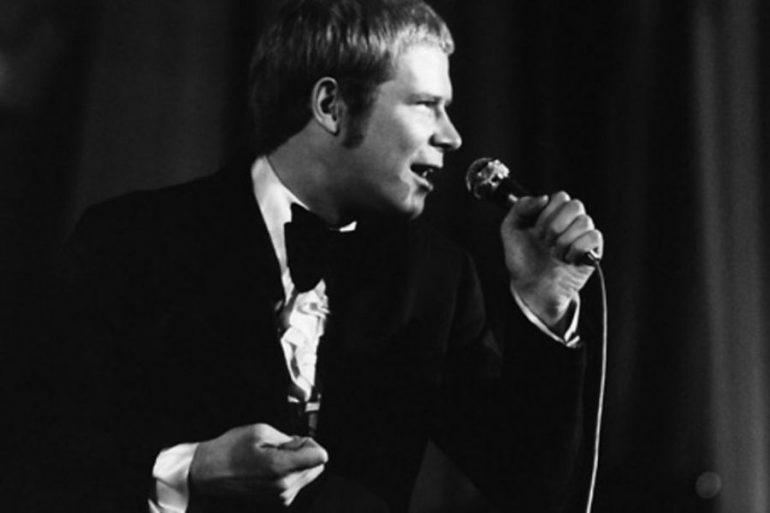John Baldry was born in 1941 and it soon became apparent that he was destined to be a tall guy. He was given the nickname ‘Long John’ in childhood, and when he grew to 6 feet 7 inches as an adult, the nickname just followed him through life.
Long John had a voice that was tailor-made for singing the blues. He began performing as a 16-year-old, and in a few years was a regular at several London clubs.
In the late 1950s and early 1960s, the idea of a coffee lounge or coffee bar was imported from America. Young people now had places where they could gather which were not pubs.
Many of these new coffee bars featured live acts, and Long John Baldry was a regular at the Gyre & Gimble Coffee Lounge near Charing Cross Station in London. He also appeared at the Brownsville R&B Club and Klooks Kleek in West Hampstead. Perhaps his best-known regular venue was on Eel Pie Island in the River Thames close to Twickenham.
At this time, at the beginning of his career, Long John was mostly singing folk-inspired and jazz-orientated material. It was only after meeting Alexis Korner that Long John became aware of the potential of R&B and made the switch that would define his future musical output.
The early 1960s were fertile years for R&B in Great Britain and the godfather of the scene was Alexis Korner. He gave many young singers and musicians their start in the business and influenced dozens of others.
Long John sang with Korner’s band Alexis Korner’s Blues Incorporated. In 1962, the band released what is considered to be the first blues album made by a British group. It was titled R&B from the Marquee.
Although it did not achieve commercial success, it was a seminal work that influenced the progress of rock music in Britain for a generation.
Embed from Getty ImagesAlexis Korner’s Blues Incorporated had a fluid membership that at times included future stars like Jack Bruce and Charlie Watts, as well as Long John Baldry. When Charlie Watts left to become the Rolling Stones’ drummer, Ginger Baker took his place.
Long John Baldry was able to meet and perform with some of the hottest upcoming young musicians and singers working in London at this time. Future stars like Eric Clapton, John Mayall, and Zoot Money benefitted from their early links with Alexis Korner.
The Rolling Stones, all of whom had played with Alexis Korner, performed their first gig at the Marquee Club in 1962. Long John Baldry put together an informal group to be the support act. He maintained his contact with the Stones, acting as an announcer on their Got Live If You Want It album in 1966.
The other hugely successful band from the early 1960s was The Beatles. Long John Baldry performed at The Cavern Club during that time and became friendly with Paul McCartney, who asked him to perform on a Beatles TV special. In 1964 he sang solo, and with The Vernon Girls, on Around the Beatles.
Cyril Davies was a great friend of Alexis Korner and was a key member of Alex Korner’s Blues Incorporated. Cyril had split from Alexis and formed his own band Cyril Davies R&B All Stars. In 1963 Long John joined the band as a singer, taking over the reins when Cyril died in 1964. The band was renamed Long John Baldry and his Hoochie Coochie Men featuring Rod Stewart as a vocalist alongside Long John.
The Hoochie Coochie Men changed their name to Steampacket in 1965. Long John and Rod Stewart continued as vocalists and were joined by Julie Driscoll as a female vocalist. Brian Auger came in as their keyboard player.
After just a year, Steampacket split up, and Long John formed a new band called Bluesology. He recruited Elton Dean as a saxophonist, who later joined Soft Machine, a keyboard player by the name of Reg Dwight and a saxophonist Caleb Quayle.
Although only shortlived, the band Bluesology had a strong influence on Reg Dwight. When he decided to go solo, he adopted a stage name that took Elton Dean’s first name and Long John’s given name to become Elton John.
While still leading Bluesology, Long John recorded a mainstream pop song Let the Heartaches Begin that reached the top of the charts in Britain. The following year he recorded Mexico, as the theme for the GB Olympic team.
By 1968, Bluesology had disbanded, with Elton John embarking on his solo career. Long John was left without a backing band and hooked up with a group called Chimera, who hailed from Plymouth in Devon. They supported him throughout the tour that he had just embarked upon.
Long John’s connection with Rod Stewart continued, however, and in 1971 they jointly produced Long John’s album It Ain’t Easy. This was to be Long John’s most popular and successful album. One song from the album “Don’t Try to Lay No Boogie Woogie on the King of Rock and Roll,” became his most successful and best known in the United States.
The following year he collaborated again with Rod Stewart in the production of the album Everything Stops for Tea. This album also charted in the United States as well as in Britain.
The mid-1970s were a difficult time for Long John, as he suffered bouts of mental illness. His recovery and return to performing was celebrated in 1978 with the release of the album Baldry’s Out. The title referred to his decision to openly declare his homosexuality. This album was recorded in Canada, where Baldry had settled. In time he became a Canadian citizen.
During the later 1970s he formed the Long John Baldry Band, and for some twenty years spent time touring throughout the USA and Canada. The band included the singer Kathi McDonald. In 1980 the pair had a hit in several countries with “You’ve Lost That Lovin’ Feelin,'” the old Righteous Brothers song.
In 1997, he released the album Right To Sing The Blues. In the Juno Awards of that year, it won a Juno Award for Blues Album of the Year. In 2002, Long John played a sell-out ten-venue tour of Canada and then in 2003 took part in the British Legends of Rhythm and Blues tour of the UK.
In July 2004, Long John did a gig in Columbus, Ohio. Later, in November of the same year, Long John undertook his last UK tour with the Long John Baldry Trio.
The quality of Long John’s voice led to his being in demand for voiceover work. During the years that he lived in Canada, he did a variety of voiceover assignments. Probably his best-known role as a voice actor was as Dr. Robotnik in the animated 1993 Adventures of Sonic the Hedgehog series.
The TV series of 65 episodes was based on the Sonic the Hedgehog video games. In the animated series, Sonic tries to protect the planet Mobius from the evil Dr. Robotnik.
Long John was also the voice of the computer KOMPLEX in Bucky O’Hare and the Toad Wars. This was another animated series, of 13 episodes, that aired in the US in 1991 and in the UK in 1992. Additionally, Long John narrated the Winnie the Pooh recordings for Walt Disney Records.
Long John’s homosexuality was an open secret in the music industry from the 1960s, although mostly the record-buying pubic were unaware. In the 1960s, homosexuality among men was illegal in the UK, so it was quite common for gay men to keep their sexual orientation secret. Conviction would often result in imprisonment.
One result of his link with Elton John was that he was instrumental in saving Elton’s life. Elton suffered as a consequence of his confused feelings about his sexuality. His relationship with a woman had caused Elton such distress that he attempted suicide.
Long John, together with Bernie Taupin, Elton’s friend and lyricist, found Elton just in time. Long John talked with a young Elton and convinced him that suicide was not the answer to his problems. On the album Captain Fantastic and the Brown Dirt Cowboy, Elton included the song “Someone Saved My Life Tonight.”
In this way, Elton sang about the experience and expressed gratitude for the help he received. It was the only song on the album to be released as a single, and although long for a single, was a hit worldwide.
Long John spent the last years of his life with his partner Felix Rexach, ‘Oz’ to his friends. They lived in Vancouver on Canada’s west coast. In 2005 Long John contracted a severe chest infection and died in hospital on 21 July.
Long John Baldry was a giant in the music industry, both physically and as a performer. During the early years of his career, he mixed with many promising young singers and musicians. Many of them he encouraged, inspired, and mentored.
During his own career, from the late 1950s through to 2004, he released a long list of albums, singles, and EPs. Some of the singles were reissued with different B’ sides. He toured widely and frequently, fronting different bands and different line-ups of his own bands.
Long John was just as happy in a large venue as in a small, intimate place. His shadow still lingers across the music industry where his positive legacy made such a memorable impact.
Similar Stories…
- Paul Kossoff – The Great Blues Guitarist That Got Away
- Tom Fogerty – The Driving Force Behind Creedence Clearwater Revival
- Brian Jones – No Jones, No Stones
- The Story Behind O Brother, Where Art Thou? – Hard Time Killing Floor Blues
- The Alice Cooper Fact Sheet – 5 Things You Need To Know - January 12, 2023
- Everybody Knows The Words, But What Is Hotel California About? - April 29, 2022
- What Is The Meaning Of Stairway To Heaven: Led Zeppelin’s Amazing 1971 Musical Epic? - April 24, 2022


